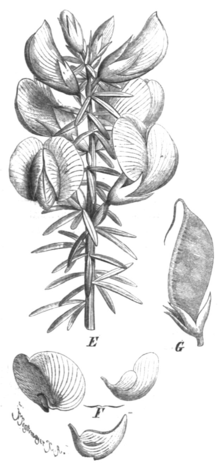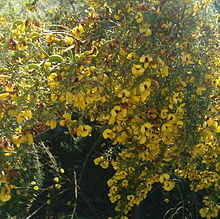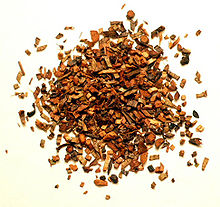- Honeybush
-
For other uses, see Honeybush (disambiguation).
Honeybush (scientific name Cyclopia spp.; Family: Fabaceae), or 'Heuningbos' in Afrikaans, is commonly used to make an infusion in the same manner as tea. It grows only in small areas in the southwest and southeast of South Africa and has many similarities with rooibos.
Honeybush is so named because the flowers smell of honey. The taste of honeybush tea is similar to that of rooibos but a little sweeter. Both are much more fragrant than any tea prepared from Camellia species, or indeed than most so-called "herbal teas". In some rural districts it used to be common practice to keep a kettle of honeybush tea infusing on the stove ready for drinking while scenting the whole house — unlike domestic tea prepared from Camellia sinensis, the product does not rapidly spoil as it simmers.
There are 23[1] or 24 [2] species of honeybush tea found in the wild, of which mainly 4 or 5 are in widespread home or commercial use. These are:
- Cyclopia intermedia, known as 'bergtee' (mountain tea), found between Port Elizabeth and the edge of the Langkloof
- Cyclopia subternata, known as 'vleitee' (marshland tea) or 'valleitee' (valley tea)
- Cyclopia genistoides, known as 'kustee' (coastal tea), found mostly in the Western Cape near Yserfontein and Darling and also thriving in the South Cape if cultivated[3]
- Cyclopia sessiliflora, known as 'Heidelberg-tee', named after the town Heidelberg in South Africa, where it grows in the local mountain range
- Cyclopia maculata,[4] grown in the Outeniqua area near George[5]
Some species can be cultivated whereas others have resisted all attempts at cultivation and must be harvested in the wild. It is not always easy to discover what the seeds need to enable them to germinate; some kinds bear elaiosomes and might be dependent on the services of particular ants or birds. Cyclopia intermedia (mountain tea) is one of the teas that is harvested in the Kouga mountains where it grows naturally. Mountain tea regenerates within three years after harvesting or devastation by fire; consequently less than one third of the mountain yield is available for harvesting each year by rotation.[6]
Mountain tea and valley tea flower in September/October whereas coastal tea flowers in May/June.[7]
There are two methods of processing honeybush for use in tea. In the traditional method, the leaves of the bush are harvested, cut and bruised (often with mechanical rollers), and then left in the sun to oxidise. The modern, industralised process oxidises the leaves in rotating, heated tanks at temperatures of 70 to 90 degrees Celsius, for two to three days. The leaves are then air dried.
Afterwards, the leaves are sifted and graded according to the application:
- Super Fine (mostly used for string & tag tea bags)
- Regular Fine (mostly used for swimming tea bags or loose tea application)
- Coarse (mostly used for loose tea application)
Contents
Chemistry
Honeybush is low in tannin (0.45%). Some of the active compounds present in honeybush include:
- Isoflavones
- Flavones
- Cinnamic acids
- Coumestans
- Xanthonoids
- Mangiferin and isomangiferin (Cyclopia subternata)[8]
See also
References
- ^ http://www.arc.agric.za/home.asp?pid=4053
- ^ http://cat.inist.fr/?aModele=afficheN&cpsidt=16036960
- ^ http://www.arc.agric.za/home.asp?pid=4053
- ^ http://www.montegotea.com/honeybush.htm
- ^ http://www.elsenburg.com/agriprobe/2005/probe2005-3.pdf
- ^ http://www.melmont.co.za/harvesting.htm
- ^ http://www.montegotea.com/honeybush.htm
- ^ de Beer D, Jerz G, Joubert E, Wray V, Winterhalter P.,"Isolation of isomangiferin from honeybush (Cyclopia subternata) using high-speed counter-current chromatography and high-performance liquid chromatography." J Chromatogr A. 2009 May 8;1216(19):4282-9
External links
- Honeybush by Subhuti Dharmananda, Ph.D., Director, Institute for Traditional Medicine, Portland, Oregon
- Honeybush by Liesl van der Walt, South African National Biodiversity Institute. Relates mostly to coastal honeybush Cyclopia genistoides.
Publications
- A. Kokotkiewicz, M. Luczkiewicz, "Honeybush (Cyclopia sp.): A rich source of compounds with high antimutagenic properties," Fitoterapia, 80,1 (2009), 3-11.
Categories:- Faboideae
- Herbal tea
- South African cuisine
- Faboideae stubs
Wikimedia Foundation. 2010.



